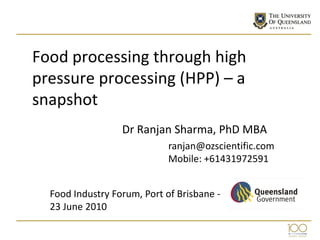
HPP Food Processing Provides Advantages
- 1. Food processing through high pressure processing (HPP) – a snapshot Dr Ranjan Sharma, PhD MBA ranjan@ozscientific.com Mobile: +61431972591 Food Industry Forum, Port of Brisbane - 23 June 2010
- 2. High pressure processing • Non-thermal processing technology • First commercialised in Japan in the early 1990s for pasteurisation of acid foods for chilled storage • High pressure treated foodstuffs have been marketed in Japan since 1990, in Europe and the United States since 1996 & Australia since 2001 • Rapid commercialisation since 2000
- 3. HPP machine Processed product out Unprocessed product in
- 4. No. Of HPP machine installation around the world - 2010 152 135 124 111 Ocea n i a 93 Asi a 82 Eur op a 79 Am er i ca 64 49 38 37 28 24 19 11 8 9 7 7 7 7 5 2 3 1
- 5. HPP product-wise application Product-wise HPP application 7% 12% 35% Vegetable products 15% Meat products Seafood & fish Juices & beverages 31% Other products
- 6. Juice & smoothie Meat & seafood HPP product examples Sauces & spreads Ready meals
- 7. HPP - Advantages • Attractive for consumers - meets demand for freshness and minimal processing as it require no chemical additives or no high temperatures • No consumer negativity e.g. irradiation and GM • Extended shelf life - wider product distribution and results in fewer product returns • Uses less energy (hence greenhouse gases) than other technologies and has the highest processing efficiency for pumpable foods • Processing can be done in final packaging which avoids post-processing contamination and tempering • Required processing times are also reduced and there are no by-products • Permits the inactivation of microorganisms and enzymes at low temperatures, while valuable low molecular constituents, such as bioactives, vitamins, colours and flavourings, remain largely unaffected